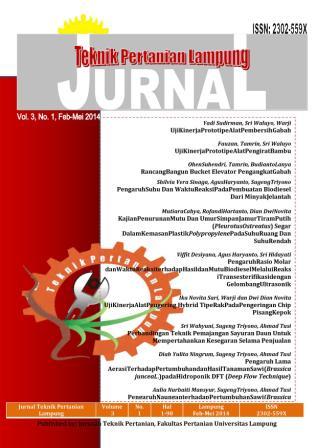UJI KINERJA PROTOTIPE ALAT PEMBERSIH GABAH
Abstract
Separation of paddy from empty grains and unexpected materials is one step in post harvest handlings done usually after cutting. This step is acquired to have the high quality of paddy. Separation that conventionally done by farmers, in general, is inefficient and can pose difficulties such us: high losses, high energy need, time consuming and depend on weather. Application of separation machine is needed as an alternatif to overcome to those difficulties. The purpose of this test is to determine the capacity and efficiency of work time required. The research was done in some steps: design of the equipment, manufacturing, testing and finally, data analysis. The test was conducted in 3 levels of wind mover: 850 rpm, 1070 rpm and 1300 rpm. Observation was focused on the percentage of empty grain, duration of separation and work capacity. From the results, it can be concluded that the best wind mover for separation was 1070 rpm. It could separate filled and empty grain effectively at 96,06%. The average of work capacity of the equipment was 127,07 kg/hour.
Keywords: Separation, rpm, Paddy.
Downloads
Published
Issue
Section
License
- Authors who publish with this journal agree to the following terms:
- Authors retain copyright and grant the journal right of first publication with the work simultaneously licensed under a Creative Commons Attribution-ShareAlike 4.0 International Lice that allows others to share the work with an acknowledgement of the work's authorship and initial publication in this journal.
- Authors are able to enter into separate, additional contractual arrangements for the non-exclusive distribution of the journal's published version of the work (e.g., post it to an institutional repository or publish it in a book), with an acknowledgement of its initial publication in this journal.
- Authors are permitted and encouraged to post their work online (e.g., in institutional repositories or on their website) prior to and during the submission process, as it can lead to productive exchanges, as well as earlier and greater citation of published work (See The Effect of Open Access).
Jurnal Teknik Pertanian Lampung

JTEPL is licensed under a Creative Commons Attribution-ShareAlike 4.0 International License.

